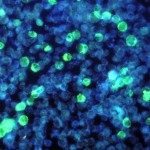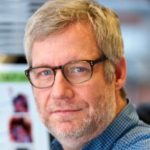Lien vers Pubmed [PMID] – 19358679
Hum. Gene Ther. 2009 Jul;20(7):784-90
Abstract Numerous strategies are under development for the correction of deleterious effects of mutations in muscular dystrophies, and these strategies must be validated in compelling models. Cellular models seem straightforward to set up; however, the proliferative capacity of muscle cells isolated from dystrophic patients is limited, and in addition it is difficult to envisage the use of large muscle biopsies from patients to obtain enough cells for ex vivo assessments. To overcome these problems, we have devised a strategy to obtain, from a patient with Duchenne muscular dystrophy (DMD), an inexhaustible source of myogenic progenitor cells with a deletion of exons 49 and 50 in the dystrophin gene. Starting material consisted of dermal fibroblasts isolated from a skin biopsy taken in a noninvasive way. These fibroblasts were first immortalized by telomerase gene transfer. Subsequent cell lines were converted into myogenic cells by means of a lentiviral vector encoding an inducible MyoD construct. Before myogenic induction, engineered DMD fibroblasts were able to proliferate infinitely. Under induction conditions, they were converted into myogenic cells, which differentiated into large multinucleated myotubes. We used these DMD fibroblast cell lines to assess dystrophin rescue by using engineered U7 small nuclear RNAs harboring antisense sequences required to restore an in-frame dystrophin mRNA by skipping exon 51. Further molecular analyses showed dystrophin rescue ex vivo as well as in vivo after engrafting of treated cells into regenerating muscles in immunodeficient mice.

